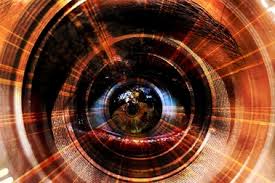The Visionary Futurist (Part 1)
By Asher Crispe: August 6, 2022: Category Decoding the Tradition, Inspirations
 Nothing makes me cringe and quake in disquietude quite like the political myopia of modernity. Were we sunk in the ruts of the dark ages, where our experience of time was estranged from notions of progress and hope was pushed off to the next world, it would be understandable, but here, in the vortex of exponential technical innovation that carries us faster and farther than ever before, we can’t be faulted for wanting more from our leaders and, dare I say, from ourselves. Who will lend the prophetic binoculars or a luminal predictive orb? While the much-needed foresight is running in short supply, small pockets of society are awakening to the prospects of a future that is not only radically different from the past but is also moving closer to us at unprecedentedly high velocity.
Nothing makes me cringe and quake in disquietude quite like the political myopia of modernity. Were we sunk in the ruts of the dark ages, where our experience of time was estranged from notions of progress and hope was pushed off to the next world, it would be understandable, but here, in the vortex of exponential technical innovation that carries us faster and farther than ever before, we can’t be faulted for wanting more from our leaders and, dare I say, from ourselves. Who will lend the prophetic binoculars or a luminal predictive orb? While the much-needed foresight is running in short supply, small pockets of society are awakening to the prospects of a future that is not only radically different from the past but is also moving closer to us at unprecedentedly high velocity.
As abstract as it sounds, the problem hinges on the deformalization of time. Our elementary education drills it into our heads that time has standard measures: an hour is an hour, a minute is a minute, a year is a year. The content of this index is entirely passive. Yet, the subsumption of all of time into the formalistic grids of clocks and calendars constitutes its taming. Time becomes phlegmatic to the ‘times’ as it is now shackled by uniformity. One day is just like another. This apparently easygoing attitude comes with some dire consequences as it places excessive emphasis on looking around in the vicinity of the present as the primary means of gathering evidence that will inform on the future. We simply come to expect more of the same. Both personal and public policy hearings spout more hackneyed rhetoric about working with what we have now as though nothing new will ever be invented.
But why insist that all development suddenly comes to a halt? All the evidence is in fact to the contrary. What we constantly witness is change. It is surprising that we can still be surprised by this. Might we venture to say that one of the operative meanings of the Torah’s insistence on a doctrine of continuous Creation–something from nothing–is an unflagging commitment to the heterogeneous character of time–of time temporalized. Thus, despite a common measure, no two times would be identical or interchangeable. Each moment would unveil something utterly new and active. Management mantras such as ‘past experience does not guarantee future experience’ and ‘more is different’ seem well-suited to this assigning of temporal unicity. All times are special. They are laden with promise. And most importantly, the certainty of the present condition does not extend into the future. A broken moment may heal rather than persist. Greeting the alterity of the future with optimism frees us from the perceived limitations of the present.
How can we round up these concepts from within the native soil of traditional Jewish experiences and then universalize them by means of an updated translation? By availing ourselves to the thinking of parallels–the puissance of kabbalistic interpretation–we can at least offer a précis to a proper futurist’s manifesto. The setup has to do with the time stamps that flank the remembrance of some of Israel’s greatest national calamities on the 9th day of the Hebrew month of Av. Taking stock of all of the long shadows cast by this burnt mark on the calendar would exceed the scope of the present discussion, so let us merely designate it as the time-trap that dates the destruction of both the first and second Temples of ancient Israel.
Suffice it to say, the Temple architecturally instantiates the consolidation of collective spirituality. As a Holy or chosen abode that acts as an amplifier for the human-Divine relationship, it functions utopically: that is, in the sense of u-topos–the absence of a place, a non-place, that paradoxically occupies a place. It provides a site-specific portal from the localizable to the non-local. And even though the first two ‘experiences’ proved unstable, the third time is a charm. The trajectory of Jewish history aims at the successful establishment of an ‘eternal house’ or permanent manifestation of what could be termed an ‘immanent transcendence.’ The ‘beyond’ somehow resides within the material limits of this structure even while it surpasses them. Building a future Temple, then, is intimately tied up with the rethinking of materialism as dematerialized or ephemeralized.
Consequently, the destruction of this edifice connotes the damaged relation between both human and Divine others. This loss of connectivity, of relatability, is stated for repair as part of the grand vision for the future. It might even be the prescience of this rectified futural state that ferries us over the traumas of our intervening history. All projections must pass though the intermediality of present and past problems which operate as a kind of gravitational lensing, assisting in the focusing on a hitherto hidden solution. Annually traversing the memory of these events compels us to observe the latent possibility that is encrusted in the husk of the actual experiences of the 9th of Av from all sides, lighting the fore and aft of this day with the expanded consciousness (also known as a Sabbath/Shabbat state) as part of the overall temporal flow.
Prying loose a few allusions from the appellation “Tisha B’Av” reinforces the multiplex of meaning that can be woven into a single expression. To begin with, nine always relates to the nine months of pregnancy. Often written with a Tet (the Hebrew letter that equates to 9), this day doubles down on the notion of pregnancy in that the form of the letter also pictographically suggests a pregnant woman [ט] in the abstract. The rest of the designation, “B’Av” (within the month of Av) literally means “within the father.” A father image not only implies the potential seed or catalyst for pregnancy but also its source. Formulated as such, the father = source (at least the abstract source) equation maintains a range of phenomena with it. To say that there is a pregnancy within the source/father signals that even a latent potential exists at the earliest stages of the genesis of this reality. Far from being predetermined, the significance is gestating within itself even before being deposited within a specific world ‘matrix’ [mother] wherein its development will become concretized.
What is intimated by gestation at the source? Could this not be compared to the Copenhagen interpretation of Quantum Mechanics, which insists that there are no ‘deep qualities’ (Quantum ignorance) to the objective world prior to our measuring of them–that our act of observation transforms and co-creates the ‘objects’ we behold. They are quite literally ‘fixed in our gaze.’ The secret of the 9th of Av is that reality itself lacks a final definition which is deferred to a future determination. When we envision it, we are not merely uncovering something that was already there (what could be equated with Classical ignorance in physics) but rather, actively projecting our sight onto a metamorphic mass. We are invested in the formative process. This sense of everything not already being here and having a definition captures the essence of the pure futurist’s pursuit whereby, in the words of Alan Kay (and many others), ‘the best way to predict the future is to invent it.’
 All of this helps to explain why the Sabbath before the 9th of Av has a special designation as the ‘Visionary Sabbath’ [Shabbat Chazon]. If there were ever a day for a futurist’s convention in the Jewish liturgical calendar, this would be it. The positioning of a Sabbath where, according to the Chassidic master Levi Yitzchak of Berditchev (1740-1809), each of us is granted a vision of the future Temple, underscores the need for foresight when grappling with the problems of history on both a personal and social scale. Similarly, the Sabbath immediately following the 9th of Av also has a singular designation as the Sabbath of Consolation [Shabbat Nachamu]. The pairing of these two Sabbaths or elevated states of consciousness, the before and after of the destruction, arrives to frame these catastrophes in an original and innovative way. The message is clear: events don’t exist in isolation. The preview and post analysis transform the nature and significance of what happens in the time stretched out between them. Reflectively, we have to assume that we are always in medias res gestating.
All of this helps to explain why the Sabbath before the 9th of Av has a special designation as the ‘Visionary Sabbath’ [Shabbat Chazon]. If there were ever a day for a futurist’s convention in the Jewish liturgical calendar, this would be it. The positioning of a Sabbath where, according to the Chassidic master Levi Yitzchak of Berditchev (1740-1809), each of us is granted a vision of the future Temple, underscores the need for foresight when grappling with the problems of history on both a personal and social scale. Similarly, the Sabbath immediately following the 9th of Av also has a singular designation as the Sabbath of Consolation [Shabbat Nachamu]. The pairing of these two Sabbaths or elevated states of consciousness, the before and after of the destruction, arrives to frame these catastrophes in an original and innovative way. The message is clear: events don’t exist in isolation. The preview and post analysis transform the nature and significance of what happens in the time stretched out between them. Reflectively, we have to assume that we are always in medias res gestating.
Following up on this bracketing of the 9th of Av with these two Sabbath ‘observances,’ our thinking of the future will continue in Part Two.
http://www.interinclusion.org/inspirations/the-visionary-futurist-part-2/
The Visionary Futurist (Part 1),















;)
;)
;)
;)
;)
;)
;)
;)
;)
;)
